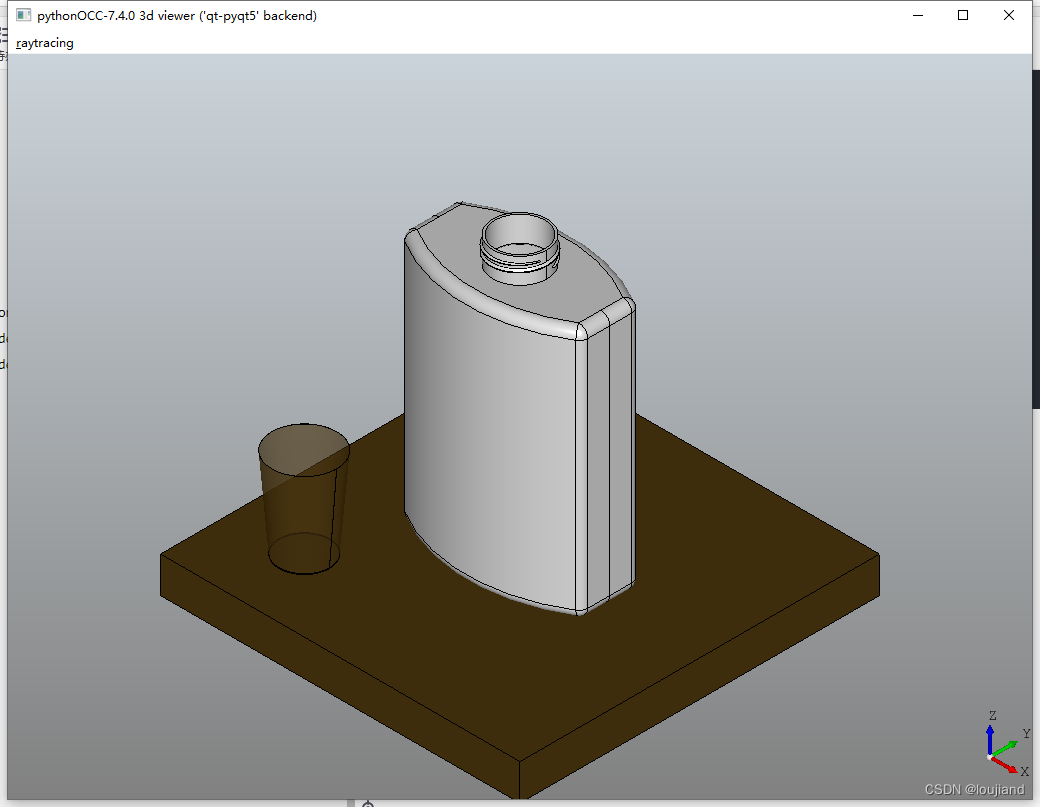源代码:
##Copyright 2010-2017 Thomas Paviot (tpaviot@gmail.com)
##
##This file is part of pythonOCC.
##
##pythonOCC is free software: you can redistribute it and/or modify
##it under the terms of the GNU Lesser General Public License as published by
##the Free Software Foundation, either version 3 of the License, or
##(at your option) any later version.
##
##pythonOCC is distributed in the hope that it will be useful,
##but WITHOUT ANY WARRANTY; without even the implied warranty of
##MERCHANTABILITY or FITNESS FOR A PARTICULAR PURPOSE. See the
##GNU Lesser General Public License for more details.
##
##You should have received a copy of the GNU Lesser General Public License
##along with pythonOCC. If not, see <http://www.gnu.org/licenses/>.
import sys
from OCC.Display.SimpleGui import init_display
from OCC.Core.BRepPrimAPI import BRepPrimAPI_MakeBox, BRepPrimAPI_MakeCone
from OCC.Core.Graphic3d import Graphic3d_NOM_PLASTIC, Graphic3d_NOM_ALUMINIUM
from OCC.Core.V3d import V3d_SpotLight, V3d_XnegYnegZpos
from OCC.Core.Quantity import Quantity_Color, Quantity_NOC_WHITE, Quantity_NOC_CORAL2, Quantity_NOC_BROWN
from OCC.Core.BRepAlgoAPI import BRepAlgoAPI_Cut
from OCC.Core.gp import gp_Vec
from OCC.Extend.ShapeFactory import translate_shp
# first create geometry
from core_classic_occ_bottle import bottle
table = translate_shp(BRepPrimAPI_MakeBox(100, 100, 10).Shape(), gp_Vec(-50, -50, -10))
glass_out = BRepPrimAPI_MakeCone(7, 9, 25).Shape()
glass_in = translate_shp(BRepPrimAPI_MakeCone(7, 9, 25).Shape(), gp_Vec(0., 0., 0.2))
glass = BRepAlgoAPI_Cut(glass_out, glass_in).Shape()
translated_glass = translate_shp(glass, gp_Vec(-30, -30, 0))
# then inits display
display, start_display, add_menu, add_function_to_menu = init_display()
# create one spotlight
spot_light = V3d_SpotLight(display.Viewer, -100, -100, 100,
V3d_XnegYnegZpos, Quantity_Color(Quantity_NOC_WHITE))
## display the spotlight in rasterized mode
display.Viewer.AddLight(spot_light)
display.View.SetLightOn()
display.DisplayShape(bottle, material=Graphic3d_NOM_ALUMINIUM)
display.DisplayShape(table, material=Graphic3d_NOM_PLASTIC, color=Quantity_NOC_CORAL2)
display.DisplayShape(translated_glass,
material=Graphic3d_NOM_PLASTIC,
color=Quantity_NOC_BROWN,
transparency=0.6,
update=True)
def raytracing_default_depth(event=None):
display.SetRaytracingMode()
def raytracing_depth_8(event=None):
display.SetRaytracingMode(depth=8)
def rasterization(event=None):
display.SetRasterizationMode()
def exit(event=None):
sys.exit(0)
if __name__ == '__main__':
add_menu('raytracing')
add_function_to_menu('raytracing', rasterization)
add_function_to_menu('raytracing', raytracing_default_depth)
add_function_to_menu('raytracing', raytracing_depth_8)
add_function_to_menu('raytracing', exit)
start_display()
运行效果:光线追踪
























 100
100











 被折叠的 条评论
为什么被折叠?
被折叠的 条评论
为什么被折叠?










